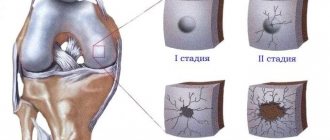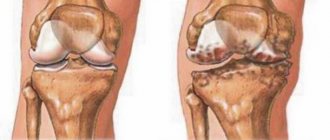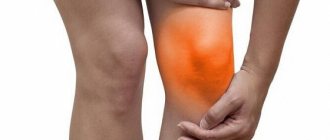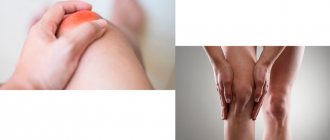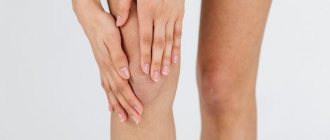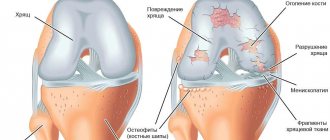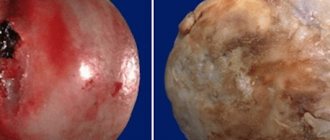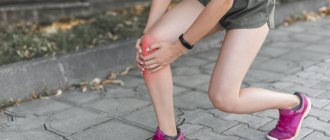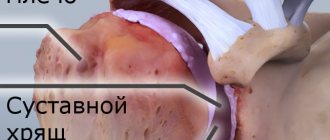Osteoarthritis deformans is a chronic degenerative joint disease. It is based on primary degeneration of articular cartilage with subsequent changes in bone articular surfaces and the development of marginal osteophytes, which entails joint deformation. 10-12% of the Russian population suffers from deforming osteoarthritis. For the treatment of deforming osteoarthritis, all conditions have been created at the Yusupov Hospital:
- Chambers with a European level of comfort;
- Equipment from leading global manufacturers;
- Individual approach to the treatment of each patient;
- Use of modern medications and innovative surgical technologies.
At a young age, deforming osteoarthritis (ICD10 code from M15 to M19) more often develops in men who have sustained injuries to the musculoskeletal system. In old age, the disease mainly affects women. With deforming osteoarthritis, the knee and hip joints are primarily affected. The degree of deforming arthrosis increases depending on the severity of joint deformation.
Course of the disease
Osteoarthritis begins with changes in the synovial fluid, which fills the joint and allows it to perform its functions. Normally, this fluid is thick and plays the role of a lubricant that nourishes cartilage tissue. When this fluid loses its properties, the cartilage surrounding the bone softens. It becomes thinner, more vulnerable and less elastic. The liquid penetrates into the cracks of the cartilage and begins to affect the bone tissue itself. As a result of these structural lesions, the joint loses its mobility.
The first signs of this degenerative process in the knee are a decrease in the functionality of the joint. When exercising, a person experiences discomfort that turns into pain if the movement is not stopped. Discomfort occurs with any tension - it is difficult to bend the leg, straighten it, or step on it. At first, discomfort appears during physical activity, but later it becomes difficult to even walk. If no measures are taken, the disease will progress and redness will appear around the knee joint and the knee will swell slightly. And after rest, the joint recovers quickly.
Grade 1 knee osteoarthritis is not usually considered a cause for concern. This is due to the fact that the discomfort quickly passes. It is difficult to even diagnose the lesion, because with rest the symptoms disappear, and the knee looks and feels completely healthy.
But it is important to understand that there should not be discomfort in the knees. It is wrong to attribute joint stiffness to age, because first-degree osteoarthritis is, in principle, considered an age-related disease. The older a person is, the more attention should be paid to the condition of the skeletal system, and in case of any difficulties, still consult a doctor. At this stage the disease is easier to stop than at later stages (2nd, 3rd degree).
A rheumatologist treats bone and joint diseases. He will conduct an examination, interview and, based on the characteristic symptoms, will suspect osteoarthritis in the initial stage. After confirming the diagnosis, simple and affordable medications are prescribed in small quantities, and the main emphasis in treatment is on proper physical activity (physical therapy), massage, diet and physical therapy.
Symptoms of pathology
At the initial stage, the disease may not manifest itself clinically at all. As it progresses, the first discomfort appears when going up or down stairs, after running, intense sports training or long walks.
When visiting a doctor, patients complain of some stiffness of movement immediately after waking up, a feeling of “tightening” on the outside of the knee. These sensations disappear quickly and are rarely accompanied by pain.
No external changes in the joint are observed. Only occasionally does the knee look a little swollen. Swelling of the skin may indicate synovitis, an inflammation of the synovium. Others with its specific symptoms are a feeling of heaviness and limited mobility.
Causes
Osteoarthritis of the knee is a disease that occurs for several reasons. The disease can be completely avoided if you follow simple recommendations. First of all, you should pay more attention to your health in general and the condition of your joints in particular. There are five most likely causes, which, if eliminated, can be avoided without medication at all in the early stages of treatment. The composition of the synovial fluid will be restored, as will the cartilage tissue, and the knee will return to normal.
- Excess weight. This is the enemy of almost all joints, especially the lower extremities. They have to bear a load that they are not naturally designed to withstand. This also includes gaining weight too quickly, in which the knee joints do not have time to adapt to the weight. For example, this is possible during pregnancy. Therefore, it is so important to monitor weight gain and avoid excesses even during this period.
- Increased loads not typical for the joint. For example, staying in one position for a long time (a disease of salespeople who have to be on their feet almost all day). This also includes sports loads in which the knees work for a long time and constantly: alpine and cross-country skiing, snowboarding, cycling, skating, running. If you feel pain in your knee after playing sports (especially when the pain is not symmetrical and affects only one joint), it is better not to continue active activities and consult a doctor for advice.
- Injuries. This includes falls, injuries and tears of the meniscus, blows, etc. If possible, you should try to prevent injury and protect your knees when playing sports.
- Hormonal disorders. It is for this reason that osteoarthritis of the knees is more common in women: the female body is constantly under the influence of one or another hormone throughout its life, and failures are common, including during age-related changes (menopause).
- Other diseases, including those that are undertreated or ignored. Arthritis, tuberculosis and others.
Development mechanism
Normally, the articular surfaces of the tibia and femur are covered with densely elastic hyaline cartilage. Its main function is to reduce the friction force during flexion and extension of the knee joint, reducing shock loads when walking. Under the influence of external or internal provoking factors, blood circulation in small intraosseous vessels through which nutrients enter the cartilage is disrupted. It becomes dry, rough, and loses its ability to retain the moisture necessary for restoration. Now the cartilaginous surfaces do not shift smoothly, but “cling” to each other. Constant microtraumas lead to thinning of the cartilage.
Symptoms and diagnosis
Stage 1 osteoarthritis of the knee has very mild symptoms that need to be treated very carefully.
- Inconvenience when moving, especially if the discomfort occurs in one joint.
- After physical activity, mild pain and even barely noticeable swelling appear. It is important to understand that this is not pain in the literal sense, but simply some inconvenience.
- Sometimes a slight crunch in the knee is added to the uncomfortable movements.
- Fatigue sets in faster than before.
People with similar symptoms are patients of a rheumatologist. To diagnose grade 1 osteoarthritis, he uses x-rays. The photographs show a slight narrowing of the joint plane and swelling of the joint capsule. After diagnosis, the doctor selects treatment in accordance with the severity of the disease.
What complications can there be?
Osteoarthritis progresses slowly but persistently. Its course is complicated by secondary reactive synovitis, spontaneous hemorrhages into the joint cavity (hemarthrosis), osteonecrosis of the femoral condyle, and external subluxations of the patella. At the 4th radiographic stage, the joint space fuses, which leads to complete or partial immobilization.
Treatment methods for grade 1 osteoarthritis
The essence of the treatment of osteoarthritis at the very beginning comes down to the return of synovial fluid to its molecular composition. This way you can improve the nutrition of cartilage and restore the surface of bones. Once mobility is restored, pain and discomfort disappear and the patient recovers.
Complex treatment:
- Eliminate the causes of the disease, if possible. It is necessary to lose weight, improve nutrition, focusing on benefits and vitamins. Those who spend a lot of time on their feet are advised to change their lifestyle and monitor the alternation of work and rest.
- Restoring hormonal balance. If there is a suspicion that the cause of the disease is the influence of hormones, the rheumatologist sends the patient to an endocrinologist. Tests show where the imbalance is hidden, and, if possible, it is corrected with medications or nutrition.
The diet for osteoarthritis consists of low-carbohydrate foods. Protein, calcium and collagen are shown. Usually they recommend adding to the menu:
- Calcium: cheese, cottage cheese
- Protein: veal, white fish, beans
- Collagen: jelly, lentils
- Vitamins: fruits and vegetables
Diet and general nutritional recommendations for arthrosis of the knee joint
A diet for arthrosis of the knee joint is necessary for patients with excess body weight. A low calorie diet and a wealth of nutrients will ensure weight loss and accelerate the recovery process of affected joints.
Nutrition for arthrosis of the knee joint should first of all be balanced. The daily diet should contain dishes enriched with beneficial vitamins and microelements necessary for the regeneration of joint tissues and maintaining the balance of the entire body.
It is recommended to give up not only bad habits (alcohol abuse and smoking), but also such dishes as:
- store-bought semi-finished products;
- fatty, spicy and overly salty foods;
- sweet carbonated drinks.
For convenience and competent planning of the diet, when treating knee arthrosis, it is recommended to keep a food diary, which disciplines and helps facilitate the process of restructuring the usual lifestyle.
Therapeutic exercise for osteoarthritis
Therapeutic exercise is your best friend in the treatment of osteoarthritis in the early stages. Sports are excluded during illness.
In the exercise therapy room, the patient is introduced to special means of knee protection - fixing bandages. They contribute to uniform load on the joint. Be sure to wear bandages on both knees, even if only one hurts!
Effective exercises for knee osteoarthritis that you can do at home.
| Initial position | Actions (perform smoothly, without straining the joints) | Quantity |
| Stand vertically with your back to the wall, arms down. | Touch the wall with your palms, shoulder blades and buttocks. Slowly rise onto your toes. Descend. | 5-7 seconds, 15-20 times. |
| Lying down, feet rest on the floor, legs bent. | Raise your right leg to knee height, straighten, hold, and lower smoothly. Repeat with your left leg. | 7 seconds, 10 times on each knee. |
How to treat arthrosis of the knee joint?
The level of modern medicine is at a fairly high level, which ensures successful treatment of various types of diseases. Osteoarthritis of the knees is no exception.
Today, there are a large number of methods for treating arthrosis of the knee joint.
At the initial stages of pathology development, predominantly conservative treatment methods are used. Conservative therapy includes:
- physiotherapeutic procedures;
- physical therapy (physical therapy);
- visiting various massages.
Progressive methods of treating osteoarthritis of the knee joint are also actively used. Among the modern effective ways to combat dangerous pathologies are the following:
- Ozone therapy is a local effect of ozone on the affected joint tissues. Helps reduce pain and stop inflammatory processes. Improves blood circulation in the problem area;
- kinesitherapy is a set of exercises for arthrosis of the knee joint, aimed at increasing its mobility and increasing blood flow.
Treatment of knee arthrosis with physiotherapy
Physiotherapy is one of the most popular methods of treating knee osteoarthritis.
Methods of physical influence, subject to a certain number of conditions, have the most positive effect on the area of localization of pathologies of various types.
Physiotherapy includes procedures such as:
- electrophoresis;
- ultraphonophoresis;
- irradiation with laser/infrared radiation;
- pulsed magnetic therapy.
The effectiveness of the procedures is individual and depends on the quality of the patient’s basic treatment plan.
Massage as a treatment for osteoarthritis of the knee joint
Massage is a useful addition to the treatment strategy for knee arthrosis.
Most experts around the world are of the opinion that massage is a mandatory component of the treatment of symptoms of arthrosis of the knee joint, which has a beneficial effect on metabolic processes and helps speed up recovery.
Knee massage can be performed both at home and within the walls of a hospital. The main thing during massage is preliminary high-quality warming up of the joint and compliance with the optimal duration of the process (from 10-15 minutes).
Treatment of osteoarthritis of the knee joint with massage should include techniques such as stroking, rubbing and kneading.
Gymnastics and exercise therapy for arthrosis of the knee joint
Exercises for arthrosis of the knee joint are an effective way to eliminate unpleasant symptoms and treat the disease.
The process of treating knee arthrosis is a rather complex and lengthy process, and physical therapy is an excellent assistant in achieving the desired result.
The type of exercise therapy and exercises for arthrosis of the knee joint are selected by a specialist individually, depending on the degree of development of the pathology and the general state of the patient’s physical fitness.
The main principle of gymnastics for arthrosis of the knee joint sounds like this: no increased loads on the affected joint, only rational, calm actions.

